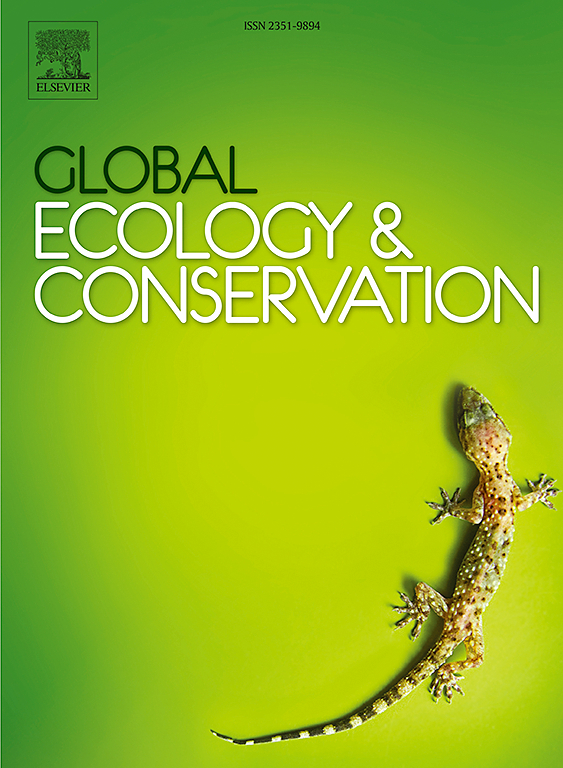内蒙古荒漠草原放牧干扰下灌木和多年生植物的空间分布
IF 3.4
2区 环境科学与生态学
Q1 BIODIVERSITY CONSERVATION
引用次数: 0
摘要
荒漠草原作为欧亚草原向荒漠的过渡地带,具有独特性。由于生态系统长期受到过度放牧的干扰,灌木和多年生植物的空间分布发生了变化。本研究旨在确定放牧干扰下灌木和多年生植物的斑块化程度,这对更好地了解荒漠草原植物群落的演替机制具有重要意义。本研究主要利用地理统计方法研究了内蒙古荒漠草原在四种放牧率(无牧,CK,0头羊-人-半年;轻度放牧,LG,0.93头羊-人-半年;中度放牧,MG,1.82头羊-人-半年;重度放牧,HG,2.71头羊-人-半年)下灌木和多年生植物的空间分布。随着放牧率的增加,多年生牧草的密度增加,而高度降低(重度放牧除外)。灌木和多年生草本植物的密度和高度呈指数下降或逐渐下降趋势。灌木和多年生植物的空间分布主要受地形、土壤母质和气候等结构因素的影响,而灌木和多年生植物的密度对放养率的变化最为敏感。适当的放牧率会增加灌木和多年生植物的空间异质性,但大量放牧会降低灌木和多年生植物的空间异质性。本文章由计算机程序翻译,如有差异,请以英文原文为准。
Spatial distribution of shrubs and perennial plants under grazing disturbance in the desert steppe of Inner Mongolia
The desert steppe is unique as a transition zone from the steppe to the desert of the Eurasian Steppe. The spatial distribution of shrubs and perennial plants has changed due to long-term disturbance caused by overgrazing in the ecosystem. This study aimed to determine the degree of patchiness of shrubs and perennial plants under grazing disturbance, which is of great significance to better understand the succession mechanism of plant community in the desert steppe. This study investigated the spatial distribution of shrubs and perennial plants under four stocking rates (no grazing, CK, 0 sheep·hm·half year; light grazing, LG, 0.93 sheep·hm·half year; moderate grazing, MG, 1.82 sheep·hm·half year; heavy grazing, HG, 2.71 sheep·hm·half year) in the desert steppe of Inner Mongolia, primarily using geostatistical methods. The density of perennial grasses increased with increasing stocking rate, while its height decreased (except for HG). The density and height of the shrubs and the perennial forbs showed an exponential or gradual decline. The spatial distribution of shrubs and perennial plants is mainly affected by structural factors such as topography, soil parent material, and climate, and the density of shrubs and perennial plants is most sensitive to changes in stocking rate. An appropriate stocking rate increases the spatial heterogeneity of shrubs and perennial plants, but heavy grazing reduces the spatial heterogeneity of shrubs and perennial plants.
求助全文
通过发布文献求助,成功后即可免费获取论文全文。
去求助
来源期刊

Global Ecology and Conservation
Agricultural and Biological Sciences-Ecology, Evolution, Behavior and Systematics
CiteScore
8.10
自引率
5.00%
发文量
346
审稿时长
83 days
期刊介绍:
Global Ecology and Conservation is a peer-reviewed, open-access journal covering all sub-disciplines of ecological and conservation science: from theory to practice, from molecules to ecosystems, from regional to global. The fields covered include: organismal, population, community, and ecosystem ecology; physiological, evolutionary, and behavioral ecology; and conservation science.
 求助内容:
求助内容: 应助结果提醒方式:
应助结果提醒方式:


